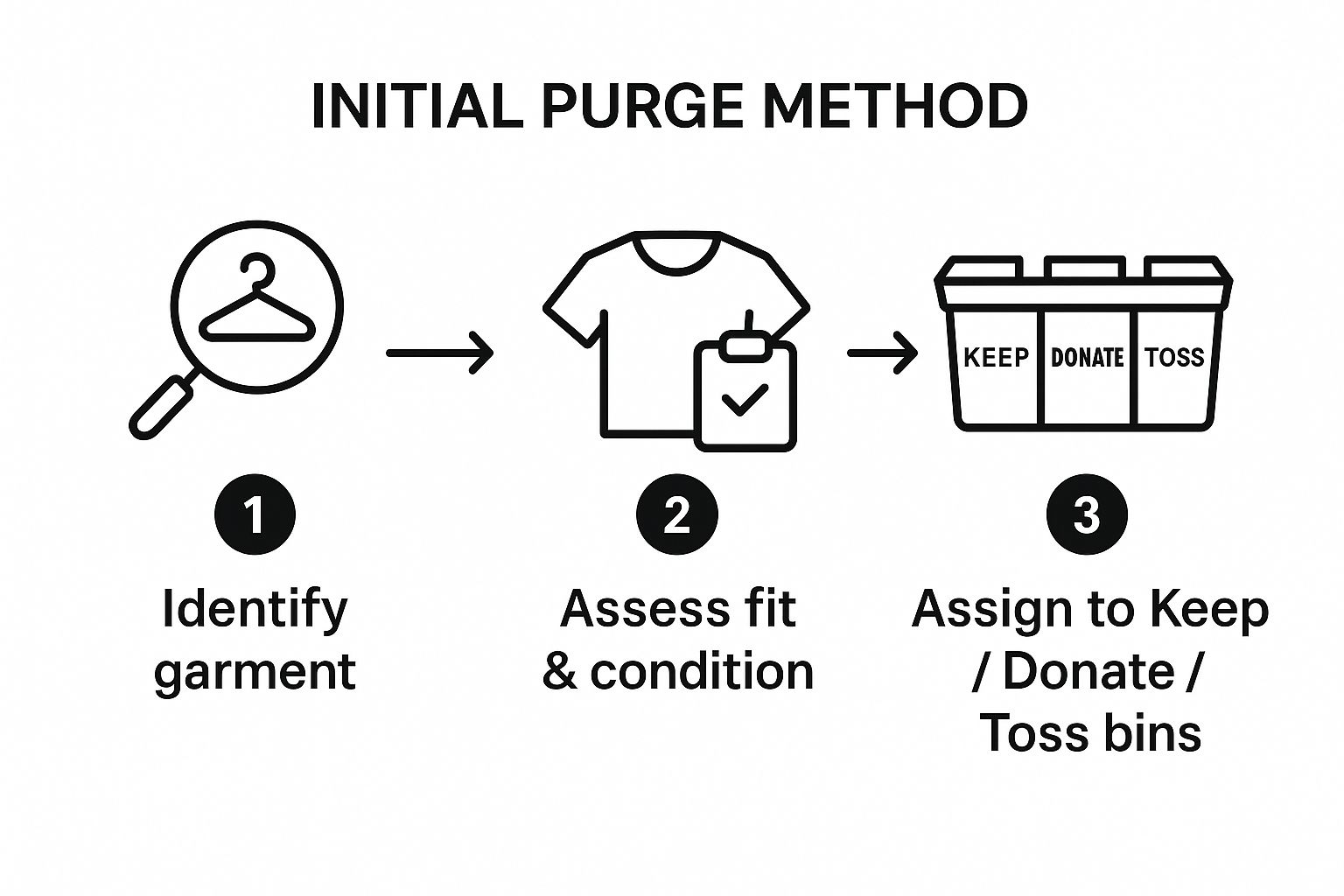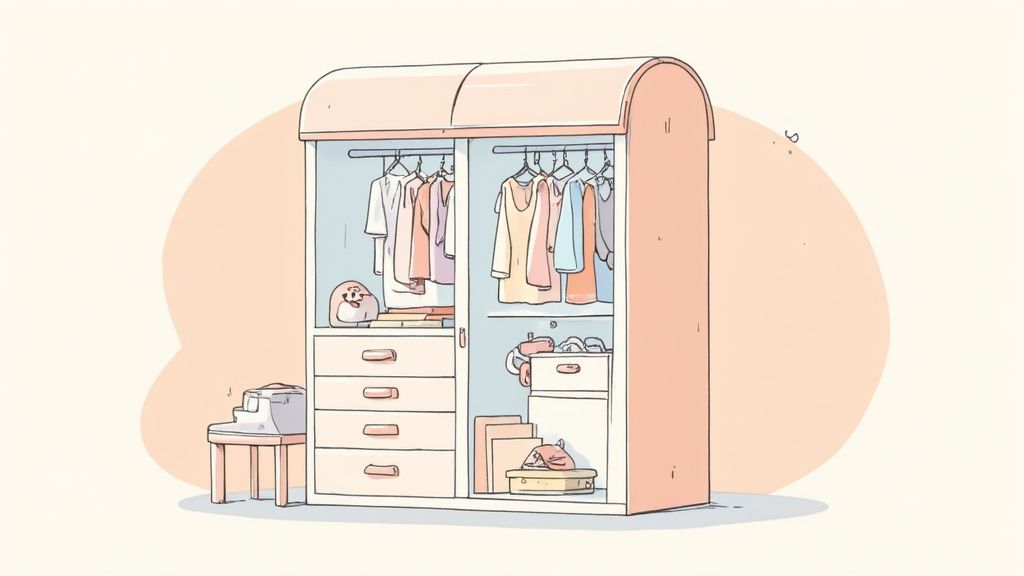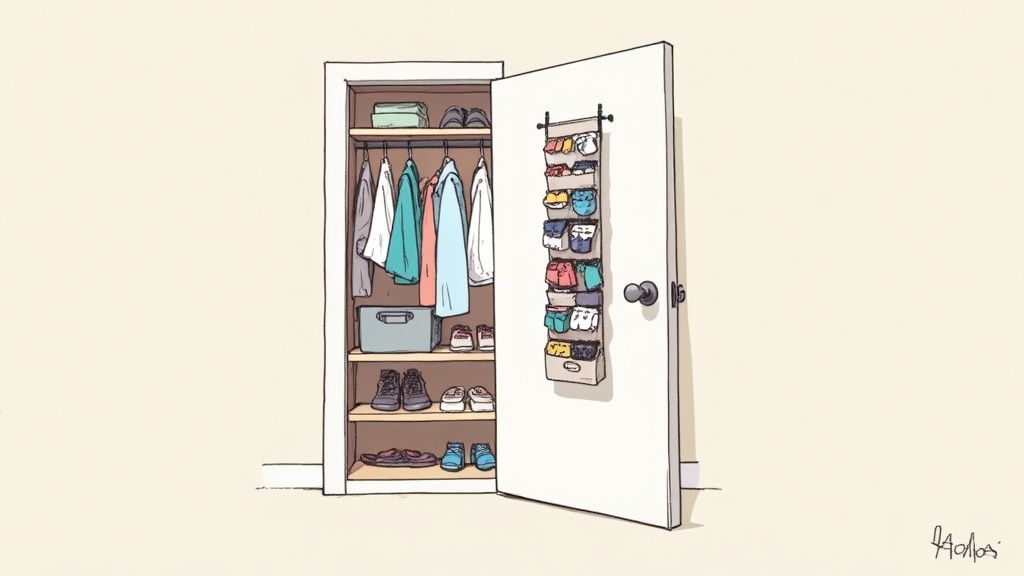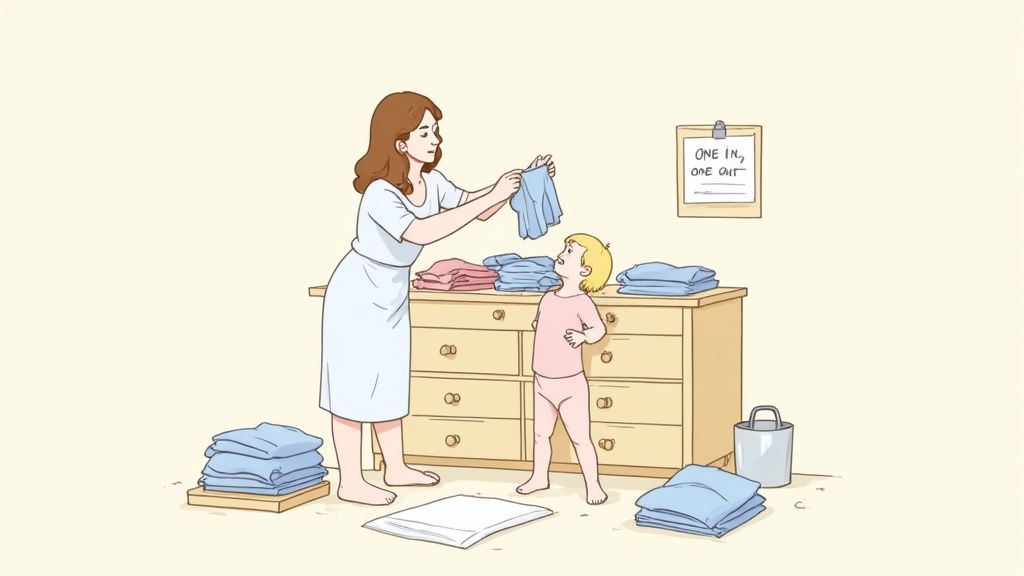Before you even think about buying a single cute storage bin or a fancy drawer divider, we need to talk about the most crucial first step: you have to declutter. This isn't the fun part, I know, but creating a system that actually works and lasts is impossible without a good old-fashioned purge.
Conquer the Mountain of Clothes First
Staring down a mountain of tiny t-shirts, pants that were too short yesterday, and a mysterious collection of single socks is enough to make anyone want to just close the door and walk away. I get it. The trick is to break it down into small, manageable decisions so you don't get stuck reminiscing over every single onesie.
The goal here isn't perfection; it's about simplifying. We're aiming to create a wardrobe that only holds clothes your child actually wears and loves right now. This initial sort makes everything that follows—laundry, getting dressed in the morning, switching out seasons—so much easier because you can finally see what you have.
The Realistic Sorting Method
Let’s be real: pulling every single piece of clothing out at once is a recipe for disaster. You'll end up with a mess you can't finish in one go. Instead, start small. Pick one category, like pajamas or t-shirts, and work your way through it.
Pick up each item and ask yourself a few quick, honest questions. Does it fit them today? Is it stained or ripped beyond repair? Do they even like wearing it? (You know the one I'm talking about—the one they always push to the back of the drawer).
To make this process fly by, I use a simple four-pile system.
Here's a quick guide to using what I call "The Four-Pile Sorting Method." It’s a straightforward way to categorize every piece of clothing and take the guesswork out of decluttering.
| Pile Name | What Goes Inside | Your Next Action |
|---|---|---|
| Keep | Clothes that fit well, are in great shape, and are in regular rotation. | Put these back in the closet or drawers once you're ready to organize. |
| Store | Off-season items or quality hand-me-downs you're saving for a younger sibling. | Pack these away in clearly labeled, airtight bins. |
| Donate | Anything in good, wearable condition that no longer fits or isn't their style. | Bag it up immediately and put it in your car to drop off. |
| Toss/Recycle | Items that are too stained, torn, or worn out to be passed on. | Find a local textile recycling program for anything beyond repair. |
Once you get into a rhythm, you’ll be surprised how quickly you can work through a drawer. This method keeps you focused on making quick decisions rather than getting bogged down.
My number one rule for keeping the clutter from creeping back in? The "one-in, one-out" policy. For every new shirt that comes into the house, an old one has to leave. It's a simple habit that makes a massive difference over time.
This flowchart breaks down the decision-making process for each piece of clothing.

Following this flow helps take the emotion out of it and keeps you moving forward. You just identify, assess, and assign. Done.
Navigating Sentimental Items
It happens to all of us. You unearth that tiny newborn sleeper or the dress they wore for their first birthday, and suddenly, you're hit with a wave of nostalgia. It’s completely normal.
But letting these precious items take up prime real estate in a drawer isn't practical. My solution is a dedicated memory box. Choose a few truly special, representative pieces to save, and then give yourself permission to let the rest go. This way, you honor the memory without sabotaging your organization efforts.
A great tip? Get your kids involved! Ask them to pick their top three favorite outgrown outfits. Letting them help decide which clothes could make another child happy is a wonderful way to teach them about letting go and the joy of giving.
Design a System That Grows With Your Child

Let’s be honest: a perfectly organized kids' closet is only useful if it works for more than a week. Kids grow, their tastes change, and their wardrobes can expand overnight. A rigid system is practically doomed from the start. That's why the best approach is to create a flexible framework that can actually adapt to their constantly changing needs.
Think of this less as a one-time project and more as building an adaptable foundation for the long haul. The real challenge isn't just the sheer volume of clothes; it's the rapid turnover. The children's apparel market was valued at around USD 211.57 billion and continues to grow, which tells you just how quickly families accumulate new stuff. This constant influx means your system needs to have a plan for clothes coming in and going out.
Create Simple Zones for Daily Life
One of the most effective strategies I’ve seen is creating "zones" in the closet or dresser. Instead of just sorting by item type (shirts here, pants there), try categorizing by function. This trick alone can simplify morning routines and empower kids to start dressing themselves because they learn exactly where to find what they need.
Some practical zones you could set up are:
- School Clothes: Everyday outfits that are comfortable and meet any school dress codes.
- Play & Weekend Wear: More casual, durable clothes perfect for the park, playdates, or messy art projects.
- Dress-Up & Special Occasions: The nicer outfits you want to keep separate and clean.
- Pajamas & Loungewear: Kept in an easy-to-reach spot for bedtime.
This method gives you a quick visual inventory. You can see at a glance if you’re running low on play clothes or have way too many fancy outfits. Making sense of sizing can also make zoning more effective; if you're struggling with that, check out this guide on understanding children's clothing sizes to get a better handle on it.
The most game-changing habit I've adopted is keeping a dedicated "Too Small" bin directly in the closet. The second I notice pants are getting short or a shirt is too snug during the laundry process, it goes straight into the bin. No second guessing, no putting it back in the drawer.
Build in Flexibility From the Start
Your system needs room to breathe and change. Those 3T clothes that fit perfectly today will be 4T before you know it, and winter coats will eventually make way for swimsuits. The key is to prepare for this inevitable shift with smart, adjustable tools.
Adjustable drawer dividers are a fantastic investment. You can reconfigure them to create small sections for tiny baby socks and then expand them for bulky toddler sweaters down the road. I also love using baskets or bins on shelves instead of relying only on fixed drawers. This gives you so much more flexibility—it's simple to relabel a "pajama" bin and turn it into a "shorts" bin as the seasons change.
Ultimately, the best system is one that truly works for your family. It should make your life easier, not add another complicated chore to your list. By creating adaptable zones and having a plan for outgrown items, you'll be well on your way to a sustainably organized space that actually stays that way.
Find Smart Storage for Any Size Room

You don’t need a giant walk-in closet to keep your kid's clothes under control. In fact, I've found that some of the cleverest organizational systems come from dealing with the challenge of a small room. The real secret is to start thinking vertically and using every forgotten corner.
Whether you've got a tiny closet, a shared bedroom, or just one dresser to work with, the goal is always the same: make everything easy to see and easy to grab. When kids can actually see all their clothes, they’re much more likely to wear different things—and maybe, just maybe, even help put them away.
Maximize Vertical Space
It's amazing how much wasted space you'll find in a standard closet. That single rod is usually way too high for a child to reach, and the floor space underneath quickly becomes a black hole for clothes and shoes. The fastest fix is to build up.
- Hanging Shelf Organizers: These fabric organizers are a lifesaver. They’re inexpensive and instantly give you a whole new set of shelves perfect for sweaters, jeans, or next week's outfits.
- Double Hanging Rods: This is my favorite closet trick. Adding a second, lower rod literally doubles your hanging space. Kids' clothes are short, so you don't need all that empty air below. Plus, it puts their favorite shirts and dresses right at their level.
- Over-the-Door Storage: Don't forget about the back of the door! A clear pocket shoe organizer is brilliant for all those little things—socks, hats, mittens, hair bows—that always seem to get lost.
These simple additions can turn a cramped closet into a surprisingly roomy spot without eating up any floor space.
The most practical way to organize kids' clothes is to think like a retailer. Use dividers to create clear categories on shelves and in drawers. This visual separation stops everything from becoming one giant, messy pile and makes finding a specific t-shirt a ten-second job instead of a ten-minute hunt.
Get Creative with Bins and Baskets
Let's be realistic—not everything is going to be perfectly folded. For things like pajamas, play clothes, or even socks, a good system of labeled bins can be a total game-changer. This "grab and go" method is way more forgiving for little hands that haven’t quite mastered folding.
Try using open-front bins or wire baskets on the lower shelves. This lets kids see what’s inside without yanking the whole thing down and causing an avalanche. I'm also a big fan of soft fabric bins, which won't snag clothes and are much safer if a toddler decides to pull one down.
If you're looking for more ideas, our guide to smart storage solutions for kids' clothes goes even deeper into systems that can grow with your child. Just remember to measure your shelves and drawers before you buy anything to make sure you get a perfect fit
Master the Seasonal Clothing Swap
Let's talk about the seasonal clothing swap. For many parents, it’s that dreaded weekend chore of hauling bins up from the basement or down from the attic. It can feel like a mountain of a task, but I've found that with a good system, you can turn it from an all-day project into something surprisingly satisfying. Think of it less as packing clothes away and more as a complete reset for your child's wardrobe.
Before a single item goes into storage, make sure it’s clean. Always wash and dry the clothes thoroughly, even if they look clean. You'd be surprised how invisible things like body oils can attract pests or turn into mystery stains after a few months in a box. This one step is the best insurance for making sure those hand-me-downs come out of storage looking just as good as they went in.
When it's time to pack, the container you choose really matters. I’d recommend staying away from cardboard boxes—they’re magnets for moisture and pests. Vacuum-sealed bags might seem like a great space-saver, but they can be tough on fabric fibers over the long haul. Your best bet? Clear plastic bins with lids that lock down securely. They keep everything safe from dust and dampness, and the clear sides mean you can see what’s inside without having to open every single one.
A Smart Labeling System That Actually Works
A good labeling system will save your sanity later. Trust me. Don't just scribble "Kids Clothes" on the lid and call it a day. Get specific!
- Size: This is non-negotiable. Put the size right on there (e.g., "4T," "5T").
- Season: Is it for "Winter" or "Summer"? A simple note makes a huge difference.
- Item Types: A quick list of what's inside helps, like "Sweaters, Long-Sleeve Shirts, Snow Pants."
A really helpful label would read something like: "Boys - 4T Winter - Sweaters & Heavy Pants." I always stick a label on at least two sides of the bin, so I don't have to unstack everything just to find the one I need.
My favorite trick is to create a "transition drawer" or a small basket for those weird, in-between weather days. I fill it with a mix of lightweight long-sleeve shirts, leggings, and a couple of cardigans. It stops me from having to rummage through the big storage bins every time the forecast flips.
Storing Sustainably and Strategically
More and more, parents are thinking about the environmental impact of what we buy. It's no secret that fabrics like organic cotton and bamboo are becoming incredibly popular. In fact, research shows that about 66% of parents now lean towards brands that use sustainable materials. This shift absolutely affects how we care for and store these clothes. When you're packing, you might want to keep delicate natural fibers separate from the tougher synthetics to help them last longer. You can learn more about how parents are shaping the children's clothing market with their choices.
Once everything is packed and labeled, find a good home for your bins. A climate-controlled spot like an indoor closet or under a bed is ideal. Try to avoid attics and basements where the temperature and humidity swings can be pretty extreme—that kind of environment can undo all your hard work and damage the fabrics over time. By putting a little thought into the process, the seasonal swap becomes a manageable part of your routine instead of a total headache.
Build Daily Habits to Keep Things Tidy

A perfectly organized closet is a fantastic start, but let's get real—it’s the small, consistent actions that prevent the chaos from creeping back in. A great system is useless if you don't build the daily routines to support it. This is how we move from a one-time project to a sustainable habit that keeps your child's wardrobe manageable for the long haul.
The trick is to weave simple tasks into your family’s daily rhythm. These habits shouldn’t feel like monumental chores. Instead, they should be quick, almost automatic actions that maintain order. Think of it like making the bed—a small effort that sets a tidy tone for the entire room.
Make Laundry Day a Finished Task
One of the biggest culprits of clothing clutter is the laundry basket that never seems to get fully emptied. We've all been there: clean clothes live in the basket for days, getting wrinkled and mixed up. The solution is to see the laundry process through to the very end, every single time.
Instead of just washing and drying, commit to the final step: putting everything away. A powerful habit is to fold or hang clothes as soon as they come out of the dryer while they're still warm. This simple change prevents piles from forming and ensures clothes actually make it back into their designated spots. For help with the washing process itself, our tips on how to care for your child’s clothes can be a lifesaver.
Involve Your Kids in the Process
Teaching kids to take ownership of their belongings is a foundational life skill, and their wardrobe is the perfect training ground. Even very young children can pitch in with age-appropriate tasks. The goal here is to make tidiness a shared responsibility, not just another thing on your to-do list.
Here are some simple ways to get them involved:
- Toddlers (2-3 years): They can put their dirty clothes in the hamper and help put away socks in a low drawer. Make it a game!
- Preschoolers (4-5 years): This is a great age for matching socks, putting their folded pajamas away, and helping choose their outfit for the next day.
- Young Kids (6+ years): They can be responsible for folding simple items like t-shirts and shorts and, eventually, putting all of their own clean laundry away.
This involvement builds competence and respect for their belongings. It’s particularly effective with tops, which make up a huge portion of a child's wardrobe. In fact, tops like t-shirts and sweaters account for approximately 25.9% of the children's apparel market. By teaching them to care for these frequently used items, you’re tackling a major source of potential clutter right from the start.
The "one-in, one-out" rule is a non-negotiable in our house. When a new t-shirt or pair of pants comes in, an old one must be donated or passed down. This simple rule single-handedly prevents the wardrobe from overflowing and forces regular, small-scale decluttering.
A Few Common Questions I Get Asked
Even with a perfect system, you're going to run into some specific challenges. It just happens. Let’s walk through some of the most common hurdles I see parents face when they're trying to get a handle on the mountain of kids' clothes. These are the straight-up, practical answers to the questions that land in my inbox most often.
How Often Should I Really Be Decluttering Kids' Clothes?
The honest-to-goodness answer? More often than you probably think, but it doesn't have to be a huge project every time.
Plan on doing a major sort-and-purge session twice a year. The best time is usually when you're swapping out seasonal clothes anyway. That's your chance to lay eyes on everything and really clear out what's not working anymore.
But here’s the real game-changer: continuous, low-effort decluttering. The single best habit I ever adopted was keeping an "outgrown" basket right there in the closet. Always.
The second you're folding laundry and realize those pants are suddenly high-waters, or a shirt is just a bit too snug in the shoulders, toss it straight into that bin. Don't even let it see the inside of a drawer again. This one simple move turns a massive, dreaded seasonal chore into a quick five-minute task because you've already done half the work.
What's the Best Way to Store Hand-Me-Downs?
Saving clothes for a younger sibling is a brilliant way to cut costs and be more sustainable, but only if you do it right. I've seen so many well-intentioned parents pull out a box of clothes only to find them musty, stained, or completely ruined.
First thing's first: always use clear plastic bins with lids that lock down securely. Stay away from cardboard boxes—they're basically a welcome mat for moisture and pests. And while vacuum-sealed bags seem like a smart space-saver, they can crush fabric fibers over time, leaving you with permanent wrinkles.
Before you pack anything away, make sure everything is washed and completely dry. Then, get strategic with your sorting. Don't just dump a pile of "girl clothes" into a bin. Group them by size and season.
Take it from me, your future self will be eternally grateful for clear, detailed labels. A great label has three key things: the size, the season, and a quick summary of what’s inside. For example: "3T Winter - Sweaters & Pants" or "18M Summer - Rompers & Tees." Stick a label on at least two sides of the bin so you can see what's what without having to unstack a tower of plastic.
Finally, where you store them matters. Find a spot inside your home that's climate-controlled, like a bedroom closet or under a bed. Attics and basements with wild temperature swings and humidity are just asking for trouble.
How Do I Get My Kids to Actually Help Keep Their Clothes Organized?
The secret to getting kids on board is making the system so ridiculously simple they can't mess it up. Your goal is to remove every possible barrier and give them a real sense of ownership over their stuff.
For little kids, visuals are king. Use picture labels on their drawers—a simple photo of socks on the sock drawer, a picture of a t-shirt on the shirt drawer. It turns cleanup into an easy matching game they can actually do themselves.
With older kids, give them some input. Let them pick out the drawer dividers or choose the color of the baskets for their shelves. When they feel like they had a hand in creating the system, they are so much more likely to actually use it. And remember, consistency is everything. Make a quick, five-minute "closet tidy" part of the bedtime routine. Before you know it, it'll become an automatic habit instead of a chore they fight you on.
At Yarafly.com, we believe that fun, comfortable clothes should be easy to manage. Our playful and durable collections are designed to make getting dressed a joy for kids and parents alike. Explore our latest styles and find the perfect pieces for your newly organized closet at https://yarafly.com.